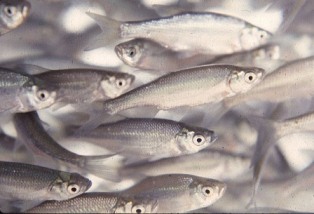Vanessa Weldon, Extension Associate, University of Arkansas at Pine Bluff
Baitfish
The freshwater recreational fishing industry pours billions of dollars of revenue into the nation’s economy, a portion of which is spent on purchasing live bait. Wild-caught baitfish cannot provide a consistent, high-quality supply to meet the demands of fishermen. Farmed-raised baitfish does so quite effectively. According to the Census of Aquaculture, 257 baitfish farms produced $38 million worth of baitfish in 2005 (USDA 2006). The farm-raised baitfish industry began in the 1940s in Arkansas and now supplies over 50% of the freshwater baitfish sold in the United States (Stone and Thomforde 2001). The baitfish industry ranks in the top five for value and sales in the aquaculture industry (USDA 2006). The majority of farm-raised baitfish is produced on large farms in Arkansas, but throughout the country, small-scale local farms are providing baitfish to local niche markets (Ogunsanya and Dasgupta 2009). While these markets do not make up a large component of the aquaculture industry in individual states, they create an opportunity for existing fish farms to diversify their production and provide a consistent supply of baitfish in areas that wild-caught bait supplies are low (McGee and Lazur, 1998).
Cultured baitfish species are also commonly used for the aquarium and feeder fish trade. Numerous species of baitfish are cultured, but the majority of baitfish species produced includes golden shiners, fathead minnows, and goldfish. These species are ideal for culture because they adapt well to pond culture, have small adult sizes, readily eat artificial feeds, will reproduce naturally in culture ponds, and are native to most regions of the United States (Stone and Thomforde 2001).
References
Edited by: Nathan Stone, Extension Section Leader-Aquaculture, University of Arkansas at Pine Bluff
Baitfish Publications
Alternative Opportunities for Small Farms: Bait Minnow Production (pdf)
An Overview of Baitfish Culture in the Northeast (pdf)
Baitfish Feeds and Feeding Practices (pdf)
Characteristics of Baitfish Retailers in Kentucky (pdf)
Commonly Raised Baitfish (pdf)
Dietary Protein and Lipid Requirements of Golden Shiners and Goldfish (pdf)
Feeding Practices for Baitfish (pdf)
Baitfish Websites
Bullfish Being Studied for Baitfish Production Released 2002.
